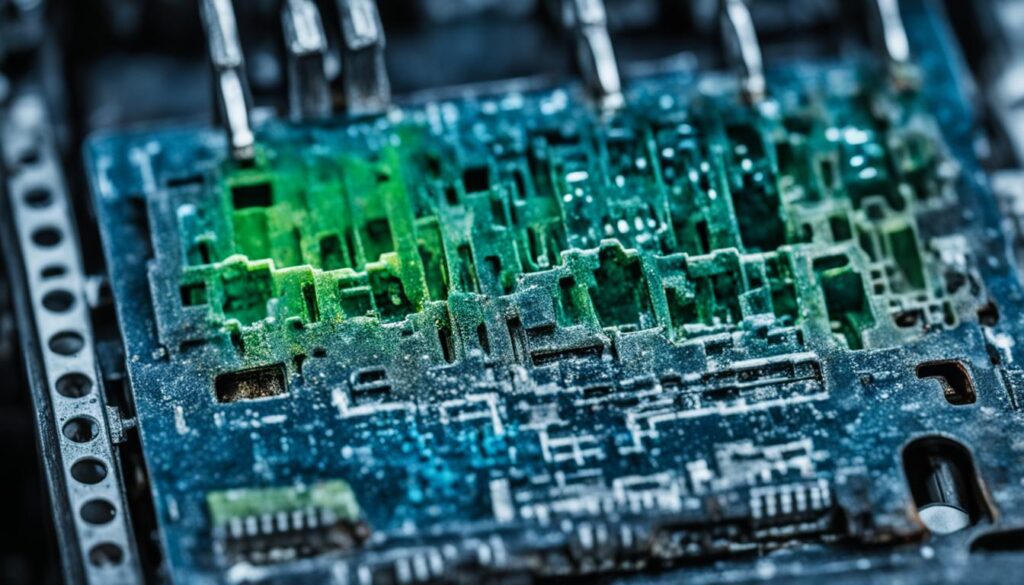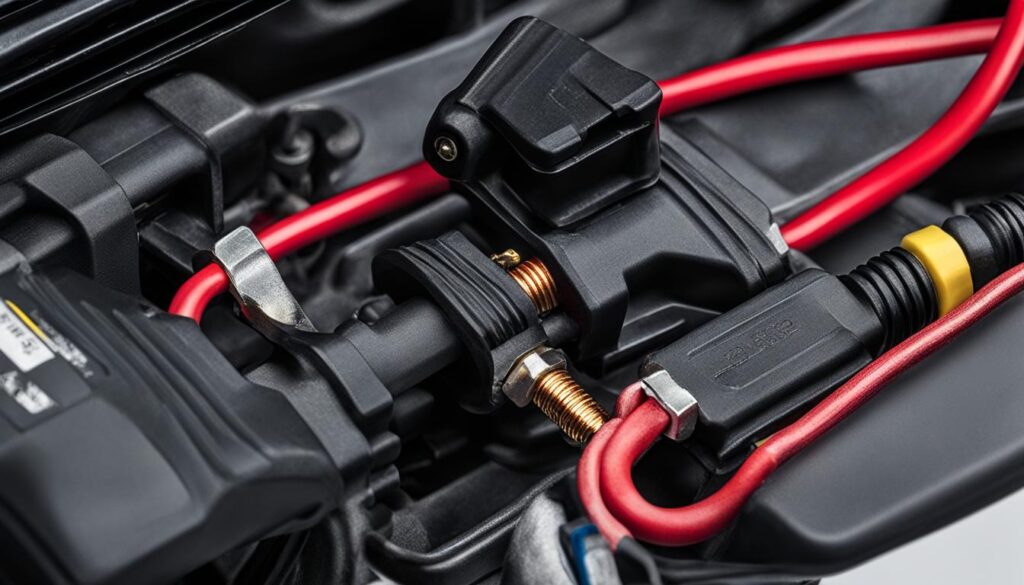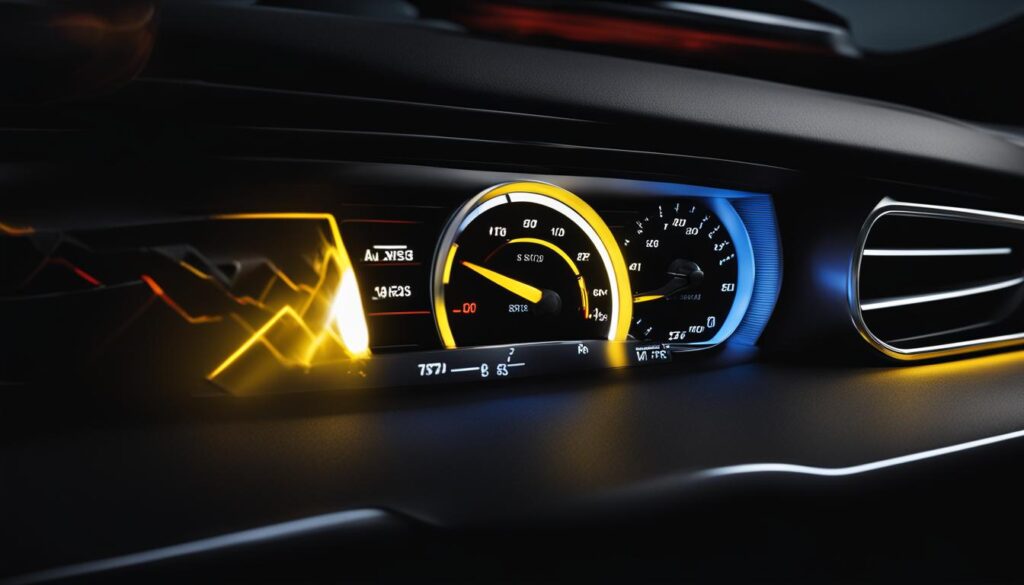Ever puzzled by your car’s battery light staying on after turning the engine on? This issue is quite common and can be confusing. It might mean your battery is failing, your alternator has a problem, or it’s something else entirely. We’ll explore car battery diagnostics to solve the mystery of this dashboard warning light.
- Various factors can cause the battery light to stay on in your car. A damaged battery, a faulty alternator or voltage regulator, or bad wiring in the electric charging system might be the culprits.
- Loose or corroded battery cables and damaged battery cells or plates are common. These issues can make the battery light stay on too.
- Before you seek professional help, you can check for corrosion on the battery terminals. Make sure the battery cable clamps are tight.
- If these steps don’t fix the issue, then it’s time to see a trusted mechanic. They can give your car’s battery a thorough check and do any needed repairs.
- Regular maintenance of your car’s battery and its charging system is crucial. It helps avoid future problems and keeps your car running well.
Takeaways>
What Does the Battery Light Mean?
The battery light on your car’s dashboard should only come on briefly when you start the car. If it stays on while driving, there’s a problem with your battery or its charging system. This might cause slow power windows or a stereo that doesn’t work.
Reasons for the battery light to stay on include loose or corroded battery cables, alternator or voltage regulator issues, damaged battery cells or plates, and faulty wiring in the car’s electric charging system.
If the battery light doesn’t go off, you should check it right away. This will prevent damage to your battery or the car’s electrical parts. Knowing the reasons behind a battery light warning helps fix the problem faster.
A common issue is loose or corroded battery cables. Battery connections can loosen or corrode over time. This weakens the battery charge and turns on the warning light. Tightening the cables often fixes this.
Problems with the alternator or voltage regulator are also typical. The alternator charges the battery, and the voltage regulator manages the electricity flow. If they’re not working, your battery won’t charge properly. This causes the battery warning light to come on.
Battery cells or plates getting damaged can also light up the battery warning. As the battery ages, its internal parts may fail. This reduces its charge and triggers the warning light.
Faulty wiring in the car’s electric charging system can be blamed too. Bad electrical connections or wiring between the battery, alternator, and regulator disrupt charging. This makes the battery warning light turn on.
While these are common causes, other issues might also cause the battery light to stay on. If you’re not sure what to do, getting professional help ensures the right fix.
Jiffy Lube has resources to help you troubleshoot battery light problems. They also offer professional battery diagnostics and repairs if you need help fixing your car’s battery charging issue.
Troubleshooting Your Battery Light
If your car’s battery light stays on, there are steps to try before seeking help.
Step 1: Check for Battery Terminal Corrosion
Corrosion at the battery terminals hampers current flow. To check, remove terminal covers and look for white or greenish deposits. If you find corrosion, use a cleaning solution or a baking soda-water mix to remove it. Then, reconnect the battery cables properly.

Step 2: Ensure Secure Battery Cable Clamps
Securely fastened clamps are critical for electrical connections. If the clamps are loose, the battery light may remain lit. Tighten them with a wrench, following your car’s manual for specifics.
Step 3: Follow Car Battery Maintenance
Keeping your car’s battery in good shape is key. This involves cleaning and checking the water level, if applicable. Also, regularly inspect the battery for damage to prevent issues.
“Regular maintenance is key to ensuring the health and longevity of your car battery.”
Step 4: Consult Your Owner’s Manual
Your owner’s manual has vital info on your car’s battery system. Use it for detailed instructions when troubleshooting the battery light.
Following these steps can help fix common issues with the battery light. Still, if problems do not resolve, professional help is advised for a thorough check and repair.
Checking for Corrosion
Corrosion at the battery terminals can block the flow of electricity from the battery to the car’s vital systems. It’s crucial to check the battery terminals for corrosion often to keep the battery working well.
First, take off any covers on the battery terminals and look for any white or greenish stuff. This shows there’s corrosion. If you find corrosion, you must clean it quickly. This keeps your battery and car’s electrical system healthy.
There are two effective methods for removing battery terminal corrosion:
- Using a Battery Cleaning Product: There are special products for cleaning corrosion from battery terminals. Use these products as the manufacturer suggests. Apply them to the corroded areas, then scrub off the corrosion with a wire brush or a special battery cleaning brush. Clean off the terminals with a cloth or paper towel at the end.
- Using a Baking Soda and Water Solution: If you can’t get a cleaning product, make a paste with baking soda and water. Mix a tablespoon of baking soda with water in a small container. Put this paste on the corroded parts of the battery terminals. Then, scrub away the corrosion with a wire brush or cleaning brush. Finish by rinsing the terminals with clean water and drying them.
Once the corrosion is gone, you need to reconnect the battery cables correctly. This makes sure the connection is secure, letting the battery work well.
Steps for Checking and Cleaning Battery Terminal Corrosion
| Steps | Method | Instructions |
|---|---|---|
| Step 1 | Remove covers | Take off any covers or protective caps from the battery terminals. |
| Step 2 | Inspect for corrosion | Look closely at the terminals for any white or greenish substance. |
| Step 3 | Choose cleaning method | Pick between a battery cleaning product or a baking soda and water mix. |
| Step 4 | Clean the terminals | Put the cleaning mix on and scrub the corrosion away with a brush. |
| Step 5 | Rinse and dry | Rinse the terminals with clean water and dry them with a cloth or paper towel. |
| Step 6 | Reconnect battery cables | Make sure the battery cables are properly attached to the terminals in the right order. |
By regularly checking and cleaning battery terminal corrosion, you can keep your car’s battery working well. This ensures your car runs reliably for many years.
Tightening Your Cable Clamps
A loose battery clamp is often why the battery light stays on in your car. The clamps, if not tight, can cause a bad electrical connection. This results in the battery light not turning off. Here are a few steps to fix this and make sure the connection is right.
- Step 1: Find the battery and see the cable clamps on the terminals.
- Step 2: Loosen the clamp screws using a wrench or socket.
- Step 3: After loosening, adjust the clamps so they fit well on the terminals.
- Step 4: Tighten the screws with the wrench until they’re firm. But don’t tighten too much to avoid damage.
Note: Always check your vehicle’s manual for the right way to tighten the clamps for your car.
By making sure the battery clamps are tight, you prevent loose connections. This step is crucial for your car’s electrical system and helps it work best.
| Pros | Cons |
|---|---|
| Tightened clamps provide a secure connection for the battery | Improper tightening can damage the clamps or battery terminals |
| Helps eliminate loose battery connections | May not resolve the battery light illumination if there are other underlying issues |
| Can be easily done with basic tools | Requires proper knowledge and caution to avoid overtightening |

What to do next?
If the battery light is still on after tightening the clamps, it might mean there are other problems. In this case, it’s best to talk to a professional mechanic. Or, check your car’s manual for advice on what to do next.
When to Seek Professional Help
If you’ve checked for corrosion and tightened the battery clamps, but the light stays on, it may be serious. This might mean issues with the alternator, voltage regulator, or the car’s electric system wiring. It’s best to get professional help to fix the issue.
At Firestone Complete Auto Care, they offer a fast, free battery check. They will tell you if you need repairs or a new battery. Their skilled team can diagnose and fix your battery, ensuring your car charges right.
Signs of Mechanical Battery Issues
Some common signs of mechanical battery issues include:
- The battery light on the dashboard stays illuminated
- Dimming headlights or interior lights
- Difficulty starting the engine
- Electrical components not functioning properly
- Frequent battery drainage
If you notice any of these issues, it’s key to fix them quickly. This stops more damage to your vehicle’s electrical system.
| Issue | Possible Causes |
|---|---|
| Alternator Problem | Faulty diodes, worn brushes, or damaged rotor |
| Voltage Regulator Problem | Incorrect charging voltage, overcharging or undercharging the battery |
| Faulty Wiring | Short circuits, loose connections, or damaged wires |
Getting a professional diagnosis is key to find the exact battery or charging system issue. Trying to fix these problems yourself can cause more damage and lead to high repair costs.
Trust a reputable automotive service for an accurate problem fix. Reach out to a professional for battery repairs or replacement if the battery light won’t turn off.
4 Steps to Take When Your Battery Light Comes On
When the battery light pops on in your car, you should act fast. Ignoring the warning could end up with a dead battery, or worse, your car could break down. I’ll walk you through four critical steps if your battery light comes on. These steps help figure out the problem and fix it. This keeps your car’s battery working well for longer.
- Step 1: Check the age of your battery
- Step 2: Ensure a secure connection
- Step 3: Clean battery terminal corrosion
- Step 4: Turn off excess accessories
The moment your battery light turns on, see how old your battery is. Most car batteries last from 3 to 5 years, depending on their use and maker. An old battery may not charge well, which can turn on the battery light. If it’s older than 5 years, you should probably get a new one to avoid issues.
A loose or bad battery clamp can also make the battery light come on. Open your car’s hood and check the clamps. If they’re loose or have corrosion, tighten them with a wrench. This makes sure your battery is well-connected to the car’s electrical system. It stops power issues.
Corrosion at the battery terminals blocks electricity and can keep the battery light on. Mix baking soda and water to clean. After taking off the clamps, scrub the terminals with this mix. Rinse with clean water and dry well before putting the clamps back. This improves connection and fixes corrosion problems.
Using a lot of electrical accessories puts pressure on the battery’s charging system. Turn off things you don’t need when the battery light is on. This reduces the load on the battery. If the light then goes off, your battery may just need a bit of time to catch up. Still, if the light stays on, you should get expert help.
By following these steps, you can often fix battery light issues by yourself. But, if the light doesn’t go away, you should see a mechanic. Dealing with a battery warning light quickly can save you from bigger troubles later. It helps keep your car running smoothly and dependably.
Contacting Custom Complete Automotive
If the battery light stays on, it’s smart to get help from a trusted mechanic. At Custom Complete Automotive, our ASE certified technicians are experts in electrical repairs. They offer the mechanic assistance you need.
Our team can handle any battery or charging system problems in your car. We provide everything from battery checks to full repairs. This ensures your vehicle runs smoothly.
Expert Mechanic Assistance
Car maintenance requires professional skills, especially for electrical systems. Our technicians are well-trained. They’re ready to tackle any electrical repair needs.
Our experts can handle any car, no matter its make or model. We offer a wide range of battery-related services. This includes replacing batteries and fixing alternators and wiring.
Exceptional Service and Quality
We aim for customer happiness at Custom Complete Automotive. You can trust us with your electrical needs thanks to our commitment to quality.
Keeping your vehicle in good shape is our top priority. Our team uses the latest tools and stays informed about new techniques. This means we’re ready for complex battery and repair tasks.
Don’t risk your car’s battery and electrical system. Reach out to Custom Complete Automotive for dependable help and services.
Learn more about our services and schedule an appointment to keep your car’s battery perfect.
Conclusion
In conclusion, if your car’s battery light stays on, it means there’s a problem with the battery or charging system. Follow the steps we talked about earlier and get professional help if needed. This ensures your car’s battery stays healthy and issues are fixed fast.
It’s important to keep your car’s battery and charging system well-maintained to avoid future problems. Do things like checking for corrosion and keeping battery clamps tight. Also, turn off extra accessories if the battery light comes on. This helps your car’s battery last longer and work better.
If the battery light still stays on after troubleshooting, it’s time to see a professional. Places like Custom Complete Automotive have experts ready to help. They have ASE and CCA certified technicians who will give your car the professional care it needs.
Keeping your car’s battery healthy and maintaining your vehicle well helps prevent sudden breakdowns. It also extends your car’s battery life, saving you time and money. Plus, it avoids the trouble of battery problems. Remember, prevention is key to keeping your car in good shape.




